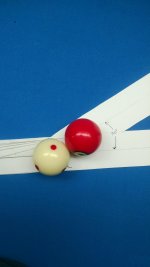I was thinking you might have a few shots laid out where the student is asked to make small, minute aiming changes to make the OB go where desired. Then as you watch, If he can do it, you might tell him whatever "aiming system" he's using is fine and that he doesn't need to worry about learning a new aiming system. But, if he can't make the small aiming changes, you might tell him it might be time to work on a new aiming system. Something like that. This fascinates me and I'd love to know your test to find this out.
Well said and so true. If you have your well tried and proven aiming system, and you trust it, then it is the best aiming system for you. If you miss the pot, you tend to attribute it to errors in cueing action.
Precision Potting Method helps you to cancel out this error in cueing action. In other words if you miss the pocket, you can be quite sure that it is your aiming system (whether tangible or gut feel) that is not quite up to par if you practice Precision Potting.
I am giving free manual for those who would like to take a look at this method.
Precision Potting Aiming System (PPAS) sprung up from this method of playing. I will not go into the principles behind it since it is too lengthy to be discussed here.
For those who have read PP, then you will understand what I am about to say about PPAS.
Scenario: It is a long shot with the OB half way down the table. It is almost straight on to the corner pocket but the pocket is maybe 5 degree off to the left.
Where should we aim? Typically, we will aim to hit the OB slightly to the right such that the OB will deflect to the left ever so slightly.
In PPAS, we will first have to find out the distance between the OB to the CB. Then we find the sweet spot for the bridge. Aim center of CB to center of OB (you can use the point where the ball touches the table top as the center of the two balls).
Now you have two options. Do you want to play right English or left English? If you intend to play right English, then move your bridge slightly closer to the CB. Pivoting and hitting the CB on the right side of the ball, the CB will deflect and swerve, and hit the OB ever so slightly on the right hand side and the OB will pot (it is a given since you have three ball diameter error to play with). If you want to play left English, then move your bridge further away from the CB. You will get the same result but with a different side-spin.
Yes, you have to practice a little on different tables (each has their own characteristic) before you start your game with your friends - this has been discussed in Precision Potting.. You will be able to make the pots with ease which you seem to find some difficulties all these while - with English on top of it.
